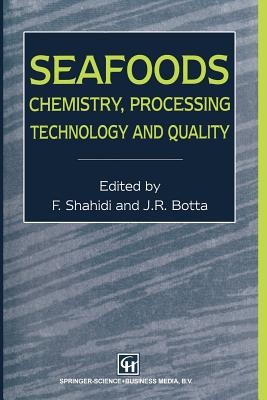
- We will send in 10–14 business days.
- Author: Fereidoon Shahidi
- Publisher: Springer
- ISBN-10: 1461359139
- ISBN-13: 9781461359135
- Format: 15.6 x 23.4 x 1.9 cm, minkšti viršeliai
- Language: English
- SAVE -10% with code: EXTRA
Seafoods: Chemistry, Processing Technology and Quality (e-book) (used book) | bookbook.eu
Reviews
Description
Seafoods are important sources of nutrients for humans. Proteins and non- protein nitrogenous compounds play an important role in the nutritional value and sensory quality of seafoods. Consumption of fish and marine oils is also actively encouraged for the prevention and treatment of cardio- vascular diseases and rheumatoid arthritis. Highly unsaturated long-chain omega-3 fatty acids are regarded as the active components of marine oils and seafood lipids. The basic chemical and biochemical properties of seafood proteins and lipids, in addition to flavour-active components, their microbiological safety and freshness quality, are important factors to be considered. A presentation of the state-of-the-art research results on seafoods with respect to their chemistry, processing technology and quality in one volume was made possible by cooperative efforts ofan international group of experts. Following a brief overview, the book is divided into three sections. In Part 1 (chapters 2 to 8) the chemistry of seafood components such as proteins, lipids, flavorants (together with their properties and nutritional significance) is discussed. Part 2 (chapters 9 to 13) describes the quality of seafoods with respect to their freshness, preservation, micro- biological safety and sensory attributes. The final section of the book (chapters 14 to 16) summarizes further processing of raw material, underutilized species and processing discards for production of value- added products.
EXTRA 10 % discount with code: EXTRA
The promotion ends in 22d.15:15:43
The discount code is valid when purchasing from 10 €. Discounts do not stack.
- Author: Fereidoon Shahidi
- Publisher: Springer
- ISBN-10: 1461359139
- ISBN-13: 9781461359135
- Format: 15.6 x 23.4 x 1.9 cm, minkšti viršeliai
- Language: English English
Seafoods are important sources of nutrients for humans. Proteins and non- protein nitrogenous compounds play an important role in the nutritional value and sensory quality of seafoods. Consumption of fish and marine oils is also actively encouraged for the prevention and treatment of cardio- vascular diseases and rheumatoid arthritis. Highly unsaturated long-chain omega-3 fatty acids are regarded as the active components of marine oils and seafood lipids. The basic chemical and biochemical properties of seafood proteins and lipids, in addition to flavour-active components, their microbiological safety and freshness quality, are important factors to be considered. A presentation of the state-of-the-art research results on seafoods with respect to their chemistry, processing technology and quality in one volume was made possible by cooperative efforts ofan international group of experts. Following a brief overview, the book is divided into three sections. In Part 1 (chapters 2 to 8) the chemistry of seafood components such as proteins, lipids, flavorants (together with their properties and nutritional significance) is discussed. Part 2 (chapters 9 to 13) describes the quality of seafoods with respect to their freshness, preservation, micro- biological safety and sensory attributes. The final section of the book (chapters 14 to 16) summarizes further processing of raw material, underutilized species and processing discards for production of value- added products.


Reviews